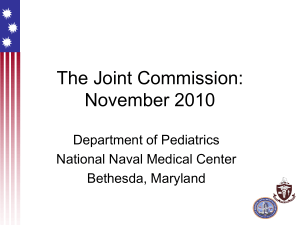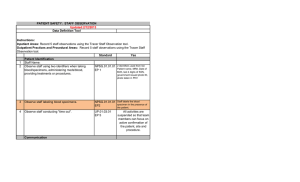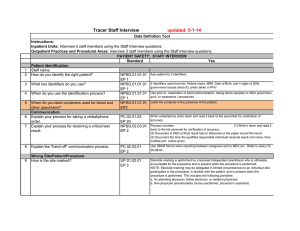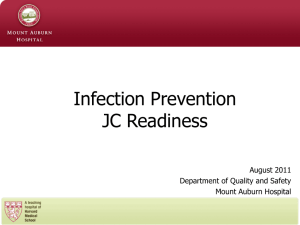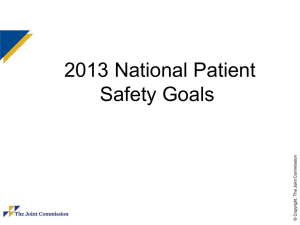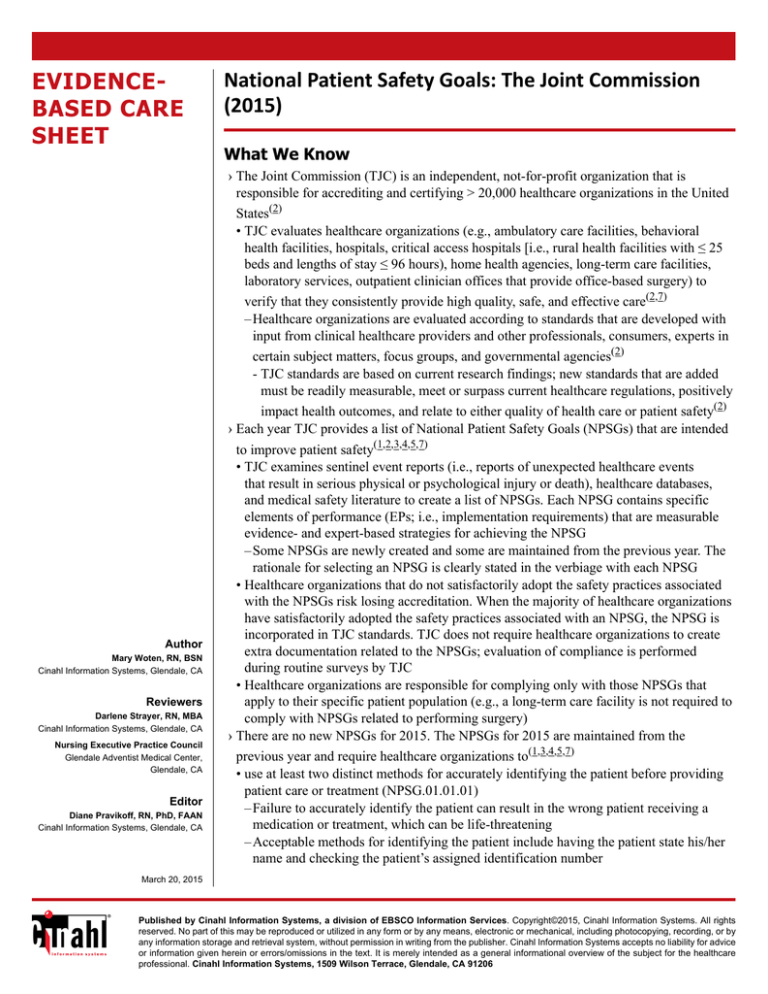
EVIDENCEBASED CARE
SHEET
National Patient Safety Goals: The Joint Commission
(2015)
What We Know
› The Joint Commission (TJC) is an independent, not-for-profit organization that is
responsible for accrediting and certifying > 20,000 healthcare organizations in the United
States(2)
• TJC evaluates healthcare organizations (e.g., ambulatory care facilities, behavioral
health facilities, hospitals, critical access hospitals [i.e., rural health facilities with ≤ 25
beds and lengths of stay ≤ 96 hours), home health agencies, long-term care facilities,
laboratory services, outpatient clinician offices that provide office-based surgery) to
verify that they consistently provide high quality, safe, and effective care(2,7)
–Healthcare organizations are evaluated according to standards that are developed with
input from clinical healthcare providers and other professionals, consumers, experts in
certain subject matters, focus groups, and governmental agencies(2)
- TJC standards are based on current research findings; new standards that are added
must be readily measurable, meet or surpass current healthcare regulations, positively
impact health outcomes, and relate to either quality of health care or patient safety(2)
› Each year TJC provides a list of National Patient Safety Goals (NPSGs) that are intended
Author
Mary Woten, RN, BSN
Cinahl Information Systems, Glendale, CA
Reviewers
Darlene Strayer, RN, MBA
Cinahl Information Systems, Glendale, CA
Nursing Executive Practice Council
Glendale Adventist Medical Center,
Glendale, CA
Editor
Diane Pravikoff, RN, PhD, FAAN
Cinahl Information Systems, Glendale, CA
to improve patient safety(1,2,3,4,5,7)
• TJC examines sentinel event reports (i.e., reports of unexpected healthcare events
that result in serious physical or psychological injury or death), healthcare databases,
and medical safety literature to create a list of NPSGs. Each NPSG contains specific
elements of performance (EPs; i.e., implementation requirements) that are measurable
evidence- and expert-based strategies for achieving the NPSG
–Some NPSGs are newly created and some are maintained from the previous year. The
rationale for selecting an NPSG is clearly stated in the verbiage with each NPSG
• Healthcare organizations that do not satisfactorily adopt the safety practices associated
with the NPSGs risk losing accreditation. When the majority of healthcare organizations
have satisfactorily adopted the safety practices associated with an NPSG, the NPSG is
incorporated in TJC standards. TJC does not require healthcare organizations to create
extra documentation related to the NPSGs; evaluation of compliance is performed
during routine surveys by TJC
• Healthcare organizations are responsible for complying only with those NPSGs that
apply to their specific patient population (e.g., a long-term care facility is not required to
comply with NPSGs related to performing surgery)
› There are no new NPSGs for 2015. The NPSGs for 2015 are maintained from the
previous year and require healthcare organizations to(1,3,4,5,7)
• use at least two distinct methods for accurately identifying the patient before providing
patient care or treatment (NPSG.01.01.01)
–Failure to accurately identify the patient can result in the wrong patient receiving a
medication or treatment, which can be life-threatening
–Acceptable methods for identifying the patient include having the patient state his/her
name and checking the patient’s assigned identification number
March 20, 2015
Published by Cinahl Information Systems, a division of EBSCO Information Services. Copyright©2015, Cinahl Information Systems. All rights
reserved. No part of this may be reproduced or utilized in any form or by any means, electronic or mechanical, including photocopying, recording, or by
any information storage and retrieval system, without permission in writing from the publisher. Cinahl Information Systems accepts no liability for advice
or information given herein or errors/omissions in the text. It is merely intended as a general informational overview of the subject for the healthcare
professional. Cinahl Information Systems, 1509 Wilson Terrace, Glendale, CA 91206
• eliminate blood/blood product transfusion errors related to the failure to accurately identify the patient (NPSG.01.03.01)
• report in a timely manner the results of laboratory or other diagnostic tests that significantly deviate from what the
organization has determined to be normal (NPSG.02.03.01)
–The organization must determine an acceptable time period for reporting results so that patients can receive prompt
treatment
• accurately label medications, medication containers (e.g., syringes), and solutions to be used in a procedure on and off the
sterile field and in other procedural settings (NPSG.03.04.01)
–Failure to accurately label medication can result in medication errors that cause patient death
• create protocols for the administration and monitoring of long-termanticoagulant therapy to reduce the risk of adverse
events (NPSG.03.05.01)
–NPSG.03.05.01 does not apply to routine short-termprophylactic anticoagulant that is administered for venous
thromboembolism prevention where the expectation is that the patient’s laboratory values will remain or be near normal
values
–Patient education should focus on the risks associated with anticoagulation therapy, necessary precautions to observe
while receiving anticoagulation therapy, and the need for frequent INR measurement
• reconcile current patient medications with new medications that are prescribed and communicate the results of the
reconciliation (NPSG.03.06.01)
–Reconciliation of medications should involve the medication indications, name, dose, frequency, and route to prevent
duplicate prescribing and drug interactions
• increase the safety of clinical alarm systems (i.e., audible electronic alarms in medical devices that are designed to alert
healthcare personnel to potentially serious changes in patient condition) (NPSG.06.01.01)
–NPSG.06.01.01 was introduced in 2014
• adhere to the guidelines for performing hand hygiene from either the United States Centers for Disease Control and
Prevention (CDC) or the World Health Organization (WHO) (NPSG.07.01.01)
• prevent healthcare-associated infection caused by multidrug-resistantorganisms (MDROs; e.g., methicillin-resistant
Staphylococcus aureus [MRSA], vancomycin-resistant enterococci (VRE), Clostridium difficile [CDI], multidrug-resistant
gram-negative bacteria) by adopting evidence-based infection control practices (NPSG.07.03.01)
• prevent central line-associated bloodstream infections by adopting evidence-based infection control practices
(NPSG.07.04.01)
–NPSG.07.04.01 applies to short- and long-term central venous catheters and to peripherally inserted central catheters
• prevent surgical site infection by adopting evidence-based infection control practices (NPSG.07.05.01)
• prevent catheter-associated urinary tract infections (CAUTI) by adopting evidence-based infection control practices
(NPSG.07.06.01)
–Evidence-based guidelines include limiting the use and duration of urinary catheterization and verifying asepsis and
the sterility of the urine collection system. Provisions for monitoring compliance and the effectiveness of the guidelines
adopted are included
–NPSG.07.06.01 is applicable to the pediatric population
• reduce patient harm related to falls (NPSG.09.02.01)
–NPSG.09.02.01 is not applicable to hospitals
–Fall risk reduction strategies should include performing an assessment of the patient’s fall history, environment,
medications, alcohol consumption, gait and balance, and use of walking aids
• use clinical practice guidelines to assess risks for and prevent pressure ulcers (NPSG.14.01.01)
–NPSG.14.01.01 is not applicable to hospitals
• identify patients who are at risk for suicide (NPSG.15.01.01)
–NPSG.15.01.01 is only applicable to psychiatric hospitals and to patients who are being treated for psychological or
behavior disorders in general hospitals
• identify risks (e.g., accidental fire) associated with the use of oxygen therapy in the home care setting (NPSG.15.02.01)
–NPSG.15.02.01 is not applicable to hospitals; TJC modified this goal for the home care accreditation program(6)
› The NPSGs include TJC Universal Protocol (UP) for Preventing Wrong Site, Wrong Procedure, and Wrong Person
Surgery(1,3,5,7)
• Performing the wrong surgery or invasive procedure on the wrong patient or in the wrong anatomic site can and must be
prevented
• The UP involves(1,3,5,7)
–conducting a verification process prior to surgery or a procedure (UP.01.01.01)
- Healthcare personnel must verify that the right patient is undergoing the right surgery or procedure, and that the surgery
or procedure will be performed in the right anatomic site
- All documentation regarding the intended surgery or procedure must be consistent with the expectations of the patient
and the healthcare team
- Presurgical or preprocedure verification can be performed multiple times before the surgery or procedure is initiated
(e.g., when the surgery or procedure is scheduled, when the patient is admitted for the surgery or procedure, when the
patient enters the room where the surgery or procedure will be performed)
–marking the surgical or procedure site (UP.01.02.01)
- Ideally the person marking the site should be the person performing the surgery or procedure
–performing a time-out prior to initiating the surgery or procedure to verify that the right patient is to undergo the right
surgery or procedure, and that the surgery or procedure will be performed on the right anatomic site (UP.01.03.01)
- All activities in the room should be suspended during the time-out, and all members of the healthcare team should
actively participate in the time-out
› Healthcare organizations (e.g., acute care hospitals, long-term care facilities, ambulatory care facilities, home care
organizations) are responsible for complying only with those NPSGs that apply to their specific patient population (e.g., a
long-term care facility is not required to comply with NPSGs related to performing surgery)(4)
What We Can Do
› Learn about the NPSGs for 2015 so you can accurately assess areas in which your healthcare organization needs to improve
patient safety in order to comply with each NPSG; share this information with your colleagues
› Contribute to making patient safety and the delivery of high-quality,cost-effective health care priorities in your clinical
area as well as your entire organization by collaborating with your nurse manager, quality assurance department, and
accreditation team to identify clear and measurable strategies for achieving each NPSG and for adhering to the UP; volunteer
to serve on your organization’s accreditation team
› Model nursing leadership skills to motivate the other nurses in your clinical area to adopt changes in clinical practice that
will help your facility achieve each NPSG and adhere to the UP
Coding Matrix
References are rated using the following codes, listed in order of strength:
M Published meta-analysis
SR Published systematic or integrative literature review
RCT Published research (randomized controlled trial)
R Published research (not randomized controlled trial)
RV Published review of the literature
RU Published research utilization report
QI Published quality improvement report
L Legislation
C Case histories, case studies
PGR Published government report
G Published guidelines
PFR Published funded report
PP Policies, procedures, protocols
X Practice exemplars, stories, opinions
GI General or background information/texts/reports
U Unpublished research, reviews, poster presentations or
other such materials
CP Conference proceedings, abstracts, presentation
References
1. Kirkpatrick, C., & Bombard, C. F. (2011). Safety first: The Joint Commission's national patient safety goals for 2012. Nurse.com, 23(23), 24-29. (G)
2. The Joint Commission. (2015). About The Joint Commission. Retrieved January 30, 2015, from http://www.jointcommission.org/about_us/
about_the_joint_commission_main.aspx (GI)
3. The Joint Commission. (2015). National Patient Safety Goals (NPSGs). 2015 hospital accreditation standards. Oakbrook Terrace, IL: The Joint Commission. (GI)
4. The Joint Commission. (2015). National Patient Safety Goals: 2015 National Patient Safety Goals. Retrieved January 30, 2015, from http://www.jointcommission.org/
standards_information/npsgs.aspx (GI)
5. Murphy, J. (2013). Joint commission national patient safety goals, 2013. Topics in Patient Safety, 13(1), 1-2, 4. (GI)
6. Revisions to National Patient Safety Goal on home oxygen use. (2014). Joint Commission Perspectives, 34(7), 3-4. (GI)
7. Special report! The Joint Commission's 2012 National Patient Safety Goals. (2011). Joint Commission Perspectives on Patient Safety, 11(8), 1-4. (GI)

